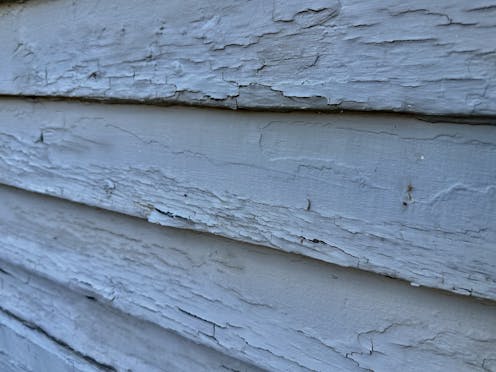
Lead is a potent neurotoxin that causes severe health effects such as neurological damage, organ failure and death.
Widely used in products such as paint and gasoline until the late 1970s, lead continues to contaminate environments and harm the health of people around the world.
The World Health Organization estimates that more than 1 million deaths each year are attributable to lead poisoning, with the highest exposures in developing nations. Lead continues leaching from old paint, pipes and industrial sources into soils, homes and waterways across the globe.
In more recent years, this number has risen at an incredible pace, with some research showing that nearly 5.5 million adults die from lead-related health complications.
I am a health physicist and my research focuses on ways to improve the technology used to screen for lead and other environmental toxicants. In developing and applying my technologies to see how people are affected by toxicants like lead, I have tested more than 20,000 people around the world over the past five years.
This preventable health crisis especially threatens children during periods of critical brain development but can also impair intellectual development and long-term health in adults. Understanding and addressing this persistent problem will require improved monitoring, targeted remediation and a great deal more awareness and dialogue.
Table of Contents
How lead damages the body
Lead enters the body through three routes: ingestion, absorption or inhalation. Once inside, lead mimics calcium by binding to proteins and enzymes where calcium is typically involved.
Lead looks a lot like calcium to many of the systems in our body. By hijacking these calcium-dependent processes, lead disrupts many normal functions ranging from neurological function to cardiovascular health.
When lead replaces calcium in these processes, it causes irreversible damage, even at low levels of chronic exposure. Studies show that low levels of lead are associated with dangerous lifelong illnesses such as Alzheimer’s and heart disease.
Furthermore, like calcium, lead accumulates in our teeth and bones. This compounds lead’s adverse effects as our bodies grow and age, since the lead in bone will reappear as our body looks to its calcium stores during periods of growth or, critically, during pregnancy.
Lead exposure can come from many sources in our daily life, from water systems using lead water lines and legacy exposures from old paint to things that people often don’t think about, such as lead in firearms or metal pots and pans.
Researchers often see exposures from soils in highly polluted areas, but sometimes it can be present in old donated toys at a child’s day care.
Late in 2023, investigators working with the Centers for Disease Control and Prevention found dangerous levels of lead in applesauce, likely stemming from a cinnamon spice grinder. This highlights the Food and Drug Administration’s failures in keeping lead out of the U.S. food supply.
Fragmented testing
Blood lead screening serves as the first line of defense against lead exposure, particularly in high-risk individuals and primarily in children. However, testing protocols and recommendations vary widely, and most states lack universal testing mandates.
Even in cases where universal screening programs exist, the data obtained can be insufficient. This is because blood tests capture only recent exposure, and universal testing oftentimes mandates only one test of children within a six-year window.
This fragmented system, combined with research indicating that many doctors deviate from lead testing guidelines, allows exposures to go undetected until irreversible neurological damage has been done.
We are hopeful that as research like ours draws more attention to the gravity of this issue, universal, standardized screening will become the norm across the U.S. This would save many children – and generations to come – from ongoing and preventable exposures.
How testing is done
Monitoring lead levels typically involves a simple blood test, generally ordered by your doctor. These tests are widely available but can easily be inaccurate based on when the test was taken. Since blood lead levels can change quickly, children who get tested several weeks after exposure could falsely test as normal.
Moreover, because there is no requirement for doctors to be trained in how to test for and treat lead exposure, many pediatricians lack awareness about lead screening protocols. As a result, many at-risk people are not being tested.
When tests are given, they may yield inaccurate results due to the rapid changes in blood lead. Or sometimes results are not properly reported to local health departments. Further complicating this, in 2010, the Centers for Disease Control and Prevention declared that the country’s progress in removing lead from gasoline was a great public health achievment. As a result, many lead-testing programs in the U.S. were discontinued, leading to critical information gaps.
However, there is some reason for optimism. Some state-based lead surveillance programs that were phased out in the early 2000s have been returning in recent years. A good example is my home state of Indiana. A law that went into effect on Jan. 1, 2023, requires all health care providers serving children to offer lead testing to their patients.
Efforts from statewide programs like these will lead to more opportunities to inform physicians and to screen vulnerable populations.
Ways to get tested
Blood is by far the most widely used indicator for lead exposure. However, in blood, lead dissipates quickly, and after about a few weeks to a month, an exposure that was high enough to cause damage is no longer measurable from blood lead.
As part of my research, we have developed a handheld device that is able to noninvasively measure lead from bone in minutes. Picture a Star Trek tricorder. We have patented the method we use to calculate lead in bone but currently have not commercialized it.

Aaron James Specht, CC BY-NC-ND
Bone lead is reflective of years to decades of exposure and is a more accurate test to reflect the permanence of damage induced by lead in the body. Bone lead has also been shown to have a strong relationship with lead accumulation in the brain, since lead hijacks places in both the bone and the brain where calcium is normally present.
Efficient and routine blood lead testing in children during their developmental stages could definitively identify exposure sources as they emerge.
While bone measurements allow researchers and physicians to effectively measure years to decades of exposure, health departments and the CDC currently lack the infrastructure to deploy this technology in communities that are highly affected by lead.
What you can do
People concerned about lead exposure should request a blood lead test from their doctor. Parents of young children should proactively ask pediatricians to conduct lead screening. If you live in an old home, especially one with peeling paint, you can contact your local health department to test for possible lead paint.
Additionally, your local water service provider should be able to tell you if lead water lines are in use leading to your home. Unfortunately, lead has no particular smell or taste to differentiate it from other possible contaminants.
Children and adults with elevated blood lead levels should talk to their pediatrician or doctor about effective follow-up testing and potential dietary changes to promote lead excretion naturally.
For very high exposures, a treatment known as chelation therapy, which involves an oral medication that binds to lead so that it can be excreted in urine, has been shown to be effective at reducing blood lead levels.
These people should also notify their local health department, which can identify and remove lead sources in their environment to eliminate the risk to both current and future residents.
![]()
Aaron Specht receives funding from the National Institutes of Health, Centers for Disease Control, and JPB Foundation.
























